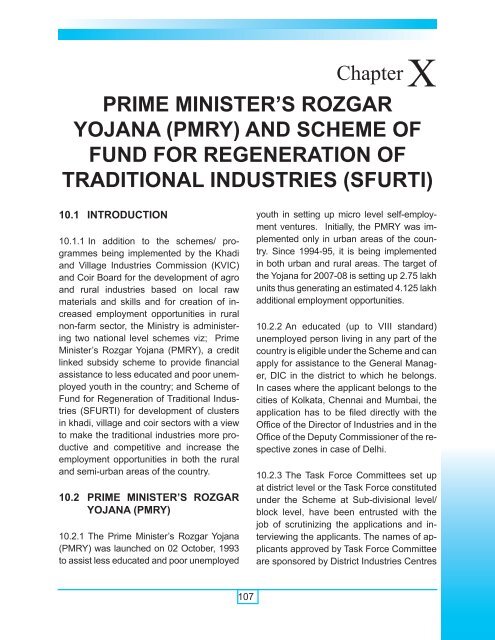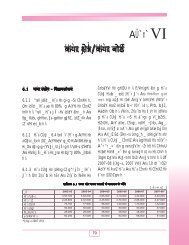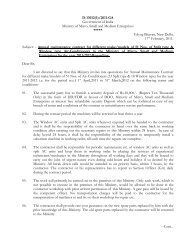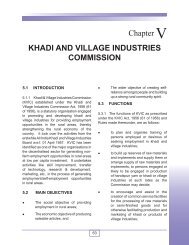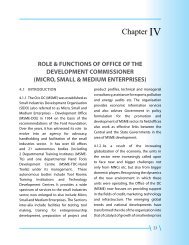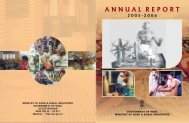PRIME MINISTER'S ROZGAR YOJANA (PMRY) AND SCHEME OF ...
PRIME MINISTER'S ROZGAR YOJANA (PMRY) AND SCHEME OF ...
PRIME MINISTER'S ROZGAR YOJANA (PMRY) AND SCHEME OF ...
- No tags were found...
You also want an ePaper? Increase the reach of your titles
YUMPU automatically turns print PDFs into web optimized ePapers that Google loves.
MSME10.2.12.2 The State-wise estimated employmentopportunities generated under <strong>PMRY</strong>during X Plan are given at Annexure –10.210.2.13 BUDGETARY ASSISTANCE10.2.13.1 The Central Government assiststhe entrepreneurs through capital subsidyand provides funds to States for entrepreneurialdevelopment, contingencies, etc. Thedetails of budget allocations and expenditureincurred under the Scheme during X Plan andduring the year 2007-08 are given in Table10.2TABLR - 10.2: Budget Allocation and FundsReleased : <strong>PMRY</strong>YearBudgetAllocationFunds ReleasedFor EDPs( Rs. crore)Total2002-03 169.00 152.55 15.55 168.102003-04 169.00 147.63 20.20 167.832004-05 218.90 190.48 27.69 218.172005-06 273.46 251.36 21.11 272.472006-07 252.60 228.82 19.69 248.51Total 1082.96 970.84 104.24 1075.08For Subsidy2007- 320.00 265.60 29.40 295.0008**Up to December 200710.2.14 EVALUATION STUDIES <strong>OF</strong><strong>PMRY</strong>10.2.14.1 Three rounds of evaluation (firstround conducted in 1996-97 for the programmeyears 1993-94 and 1994-95, secondround conducted in 2000-01 for theprogramme years 1995-96 to 1997-98 andthe third round conducted during 2005-06for the programme years 1998-99 to 2001-02) of the <strong>PMRY</strong> have been undertaken bythe Institute of Applied Manpower Research(IAMR), New Delhi. A comparative positionof some of the important findings of thesethree rounds of evaluation indicates:• The share of SC/STs as well asOBCs in the Scheme has steadilyimproved. The proportion of SC/STsimproved from about 12 per cent inthe first round to 13 per cent in thesecond and further to 21 per cent inthe third round. Similar improvementhas also been observed in respect ofthe share of OBCs. However, therehas not been much improvement inthe share of women beneficiariesunder the Scheme.• The average amount of loan disbursedhas been increasing. It wasRs. 57,000 in the second round andRs. 64,000 in the third round.• The employment generation washigher in the first round at 2.5 perunit. In the second and third rounds,it is found to be around 1.95 perfunctioning unit.• The proportion of rural beneficiarieshas come down from 49.9 per centin the second round to 39.1 per centin the third round.• Assets have been created in 89.7per cent of the cases where loanswere disbursed.• About 36.4 per cent of the beneficiarieswere repaying the loan installmenton time.• The average rate of recovery ofloans was 29 per cent in the secondround. It improved somewhat at 38per cent in the third round.110
Annual Report 2007-200810.2.15 Initiatives Taken ForStrengthening Pmry10.2.15.1 Based on the recommendationsof the Group (June 2006) constituted underthe Chairmanship of the Adviser (VSE),Planning Commission to review the designand implementation of the Yojana, some importantcomponents, viz; enhancement inthe family income ceiling, project cost, subsidy,training cost reimbursement, etc. havebeen revised in the guidelines of the <strong>PMRY</strong>with effect from 2007-08.10.2.15.2 In the quarterly schedule fixed forthe year 2007-08, applications to the extentof 125 per cent of the target are targeted tobe sponsored by the end of the third quarter(100 per cent by the end of the secondquarter), so that loans could be sanctionedin 90 per cent of the sponsored cases by theend of the third quarter (100 per cent by theend of 4th quarter). The quarterly schedulefurther prescribes that loans would be disbursedin 75 per cent cases by the end ofthe third quarter and the loan disbursementof the entire target of 100 per cent caseswould be achieved by the end of 4th quarter.The RBI has also issued instructions toall implementing banks reiterating the abovedecision of the Government.10.2.15.3 To improve the success rate ofeligible applicants, a new concept of premotivationalcampaign has been introducedw.e.f. 2007-08. Under this programme, State/UTs are allowed reimbursement of cost ofcounseling and guiding the applicants @Rs.200/- per applicant, for 125 per cent ofthe allocated target. Besides, a number ofoperational guidelines have been issued tomake this Yojana more effective which interaliainclude:• Seminars to be held at the level ofeach district for creating awarenessof <strong>PMRY</strong> in the area in the form ofpre-selection motivational campaign.A resolution be adopted byeach and every Gram Panchayatfor giving wide publicity and spreadingawareness about the Scheme intheir respective jurisdictions.• All the members of the Task ForceCommittee would be collectivelyresponsible for selection of beneficiaries.This would ensure that theBank Manager alone is not held responsiblefor the non-performing assetsif any, that could arise out of theloans extended under <strong>PMRY</strong> to thebeneficiaries.• No collateral shall be insisted for<strong>PMRY</strong> loans upto Rs. 5 lakh.• SC/ST and beneficiaries from minoritycommunities should be targetedin such a manner that they are benefited,at least, in proportion to theirpopulation in each District/State.• Of the total target for each State/UT,women beneficiaries should constituteat least 30 per cent.• Preference may be given to developclusters specializing in specificproducts at the time of selection of<strong>PMRY</strong> beneficiaries.• According to the findings of the evaluationstudies of <strong>PMRY</strong>, the ratio ofapplications received to the targetswas low owing to inadequate publicityof the scheme. As such aggressivepublicity campaigns have beenasked to be undertaken through111
MSMEmedia like radio, television, cinemaslides and distribution of pamphlets,in addition to pre-selection motivationalcampaigns.10.3 <strong>SCHEME</strong> <strong>OF</strong> FUND FOR RE-GENERATION <strong>OF</strong> TRADITION-AL INDUSTRIES (SFURTI)10.3.1 In pursuance of the declaration in theNational Common Minimum Programme ofthe present Government and that of the FinanceMinister in his Budget Speech of 2004-05, announcing the setting up of a Fund forRegeneration of Traditional Industries withan initial allocation of Rs. 100 crore, the Ministrylaunched a scheme titled “Scheme ofFund for Regeneration of Traditional Industries(SFURTI)” for development of around100 clusters in khadi, village and coir sectorswith a total cost of Rs. 97.25 crore overa period of 5 years (beginning 2005-06) witha view to make these industries more productiveand competitive and increase theemployment opportunities in both the ruraland semi-urban areas of the country. TheScheme covers an estimated 50,000 beneficiaryfamilies.10.3.2 The objective of SFURTI is to establisha regenerated, holistic, sustainable andreplicable model of integrated cluster-baseddevelopment of traditional industries in KVIand coir sectors. This will primarily mean:‣ more competitive traditional industrieswhich are market-driven,productive, profitable and providesustained employment for the participants;‣ strengthened local socio-economicgovernance system of the industryclusters, with the active participationby the local stakeholders that canhelp continuous undertaking of developmentinitiatives by themselves;and‣ building up innovative and traditionalskills, improved technologies,advanced processes, market intelligenceand new models of public-privatepartnerships, so as to graduallyreplicate elsewhere similar modelsof cluster-based regenerated traditionalindustries.10.3.3 SFURTI is a Central Scheme, and isbeing implemented by the Ministry (erstwhileMinistry of Agro & Rural Industries) withoutany share of financial contribution by theState/UTs.10.3.4 The following support measures areplanned to be taken up in the selected clusters:• Replacement of charkhas and loomsin khadi sector.• Setting up of Common Facility Centres(CFCs).• Development of new products, newdesigns for various khadi and villageindustry (VI) products, new/improvedpackaging, etc.• Market promotion activities.• Capacity building activities, such asexposure visits to other clusters andinstitutions, need-based training,support for establishment of clusterlevel networks (industry associations)and other need based support.• Other activities identified by the ImplementingAgency (IA) as may be112
Annual Report 2007-2008necessary for the development ofthe cluster as part of the diagnosticstudy and included in the Annual ActionPlan for the cluster.10.3.5 KVIC and Coir Board are the NodalAgencies (NAs) for implementation of thescheme and also responsible for holdingand disbursing funds to the identified ImplementingAgencies (IAs) and monitoring ofthe Scheme under the overall supervisionof the Scheme Steering Committee (SSC).The Secretary (MSME) is the Chairman ofSSC and representatives of the PlanningCommission, State Bank of India, IndianBank Association and National Bank for Agricultureand Rural Development (NABARD)are the members of SSC.10.3.6 Implementing Agencies (IAs) underSFURTI are non-Government organizations(NGOs), institutions of the Central and StateGovernments and semi-Government institutionswith suitable expertise which undertakecluster development. Generally, one IA hasbeen assigned only one cluster. The selectionof IAs, based on their regional reputationand experience of working at the grassrootlevel, has been done by the NAs, withapproval of SSC.10.3.7 Under this scheme, 18 reputed nationallevel institutions with expertise in clusterdevelopment methodology have beenappointed as Technical Agencies (TAs) (Annexure10.3) to provide technical support tothe NAs and the IAs. The responsibilitiesof the TAs also include assisting the NAs inidentification of clusters, conducting trainingof the Cluster Development Executives(CDEs) and other officials of the IAs andNAs, validation of cluster action plans, monitoringand evaluation, etc.10.3.8 The Cluster Development Executives(CDEs) have been appointed exclusively foreach cluster and are located in the cluster onfull time basis and responsible for implementationof the Scheme in the assigned cluster.The CDEs have to undergo prescribedtraining in cluster development methodologyto be organized by the NA through the TA.The responsibilities of CDEs include conductingthe diagnostic study, preparing andimplementing the annual action plans of thecluster, promoting linkages with institutions,building the local governance framework,etc.10.3.9 By the end of December 2007, 124clusters (34 – khadi, 64 - village industriesand 26 – coir) covering all the States havebeen approved by the SSC for their developmentunder SFURTI. The State wise detailsof clusters are given at Annexure – 10.4.The other activities for development of clusterslike consent of State Government, trainingof NAs, IAs, CDEs, etc., diagnostic studyreport and annual action plan, etc. in most ofthe cases have been completed. It is expectedthat a good number of clusters approvedunder SFURTI will be operationalised by theend of the current financial year.10.3.10 The release of funds under thisscheme will be cluster specific. The fundsare released directly to the Nodal Agencies,which are also responsible for holding anddisbursing the funds, on receipt of utilizationcertificate and depending on actual physicalprogress. The funds for development ofclusters are kept in a separate account bythe NAs which will be audited. The details ofthe funds released to NAs since inception ofthis Scheme and funds earmarked for 2007-08, are given in Table 10.3113
MSMETABLE - 10.3: Funds Released: SFURTI(Rs. crore)Year KVIC Coir Board Total2005-06 1.12 0.38 1.502006-07 19.03 6.50 25.532007-08* 3.44 3.25 6.69(21.00*)*RE10.3.11 SFURTI is the first organized andsystematic attempt at introducing clusterbased development approach in rural and traditionalsectors of KVI and coir. This approachrequired considerable efforts at identificationand short listing of clusters, IAs and CDEs besidesproviding specific professional trainingon cluster development to Nodal Agencies,IAs and exposure to Technical Agencies onthe specific needs of these sectors. Obtainingconsent of State Governments and preparationof diagnostic study reports, thereafter, requiredsome special efforts and time. Almostall the clusters are now in a take off stage and7 clusters in KVI sector have already beenlaunched. All coir clusters are ready to be operationalisedsoon. The benefits are expectedto start flowing from 2008-09 with the installationof equipment and availability of other envisagedtechnical/non-technical support. Thepace of expenditure under the Scheme is, accordingly,expected to pick up from 2008-09.114


